Books
A Dangerous Inheritance (2012)

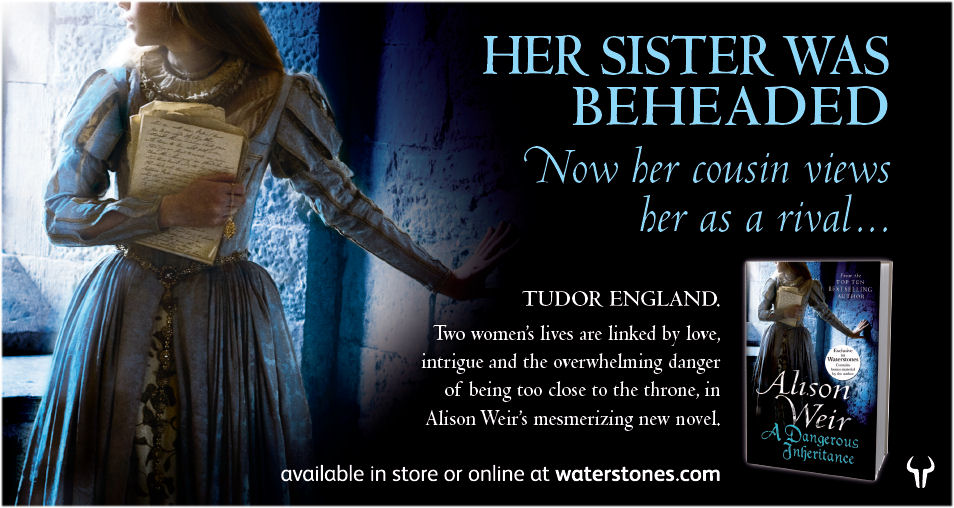

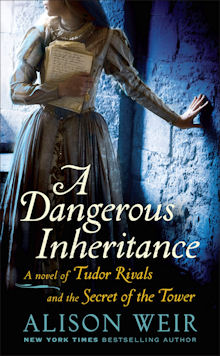
"A Dangerous Inheritance approaches the story of Lady Katherine Grey in a new and innovative way. [It] is sharp and pungent at times in its consideration of early modern politics and identity." (History Today)
"I have just finished it and I loved it! I was totally spellbound and wrapped up for two days. I can't tell you the amount of times I held my breath, and cried. I have a little boy and am very glad I am not born into royalty! Absolutely brilliant, am so looking forward to working the book!" (Fenella Davidson, Publicity Manager, Random House Australia)
"[The story in] Alison Weir's stunning new novel [is] told with suitably dramatic embellishment... Weir's spine-tingling tale leaves us in no doubt that Katherine's transgression is not one of sex or etiquette but the unpardonable one of being born to the blood royal... Weir spins a story with as many twists and turns as a spiral Tower staircase, down which we eagerly follow her. It all makes for a richly layered cake of love, sex, danger, death and mystery, put together by Weir's impeccable scholarship. Not for nothing is she among our top five bestselling historians, as she knows how to tell a hypnotic yet factual tale. It seems we cannot get enough of the Tudors, and with Weir as our guide through the labyrinth, we are in an expert's confident hands." (Nigel Jones (author of Tower), Sunday Express)
"Historian Alison Weir, who has found a fresh and firm footing as a novelist, plucks two little-known characters from the footnotes of English history and intertwines their fates in an enthralling tale of murder, mystery and love. A Dangerous Inheritance, Weir’s third and undoubtedly best historical novel, is proof indeed that she has mastered the popular and beguiling ‘faction’ formula in which fictional events slip seamlessly into an authentic historical framework.
"Alison Weir has produced a terrific book, full of vivid storytelling, fascinating history and all those ingredients – romance, danger, mystery and suspense – which bring the past to life in such stunning detail, colour and atmosphere.
"An entertaining and absorbing read from the new queen of historical fiction." (Lancashire Evening Post)
"Alison is an impeccable researcher, a brilliant writer and a gifted storyteller... Full of romance and history - you'll be enthralled." (Your Family Tree magazine)
"Renowned historical biographer Weir [writes] a novel set against the tumultuous political backdrop of two eras, Plantagenet and Elizabethan. . . Alternating viewpoints, an intriguing unsolved mystery, ghosts, romance and history entangle to present a plausible, well-written blend of fact and fiction." (Romantic Times)
"Weir stands with equally secure footing in history and fiction. Her latest book finds her on familiar historical terrain, this time in a fictional journey creatively connecting two time periods... A novel compelling in its complexity." (Booklist)
"What a wonderful story, and what fabulous characters you have created. It was inspired choosing the two Katherines like that, as their stories were interlinked in a way that is not immediately obvious. You brought them to life beautifully, and I found could relate to each one equally. I also liked the way the story evoked the feel of the period; everything became real, lifted out of dusty archives and brought to vivid life. One scene I particularly liked was the one where Katherine became aware of the presence of Kate and immediately formed an affinity with her." (Josephine Wilkinson, author of Richard III: The Young King To Be)
"Weir cleverly tells the story of Katherine Grey, while at the same time telling the story of Kate Plantagenet... Weir takes a unique approach... She also offers a balanced portrayal of Richard III." (Portland Book Review)
Ladies Home Journal book reccomendation.
"The stories of two Englishwomen, born a century apart, are a juicy mix of romance, drama and Tudor history - and pure bliss for today's royal watchers." (Ladies Home Journal)
“Beautifully written . . . the story of these two women [is] highly compelling [with] plenty to keep readers enthralled.” (Historical Novel Review)
“A page turner . . . too juicy to put down. Alison Weir’s strong suit as a fiction writer is making her novels living history.” (The Courier-Journal)
“With its evident in-depth research and creative twists, this tale of two women trying to make sense of the power of the English crown is nothing short of riveting.” (Library Journal - starred review)
“No one alive knows as much about the Tudors as Weir. Any reader of Hilary Mantel’s excellent Tudor evocations will want to explore this book as well.” (Kirkus Reviews)
“A Dangerous Inheritance is a must-read for any lover of English historical fiction.” (Luxury Reading)
“A tale of two voices, two eras, and two royal upheavals . . , by far [Weir’s] most ambitious and satisfying novel to date.” (Open Letters Monthly)
"Stunning Tudor fiction." (Bookbub)
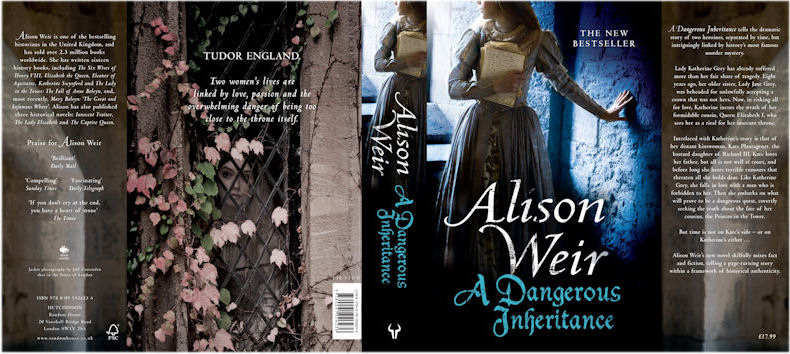
My fourth historical novel was published on 21st June in the U.K. and on 2nd October in the U.S.A.. The jacket image was shot in the Tower of London, where the heroine, Lady Katherine Grey, was imprisoned. What is the significance of the pendant she is clutching? Is it possible that the secret papers she is holding contain the truth about one of the greatest mysteries in history? And why is Katherine so scared...?

A Dangerous Inheritance is the stand-alone sequel to Innocent Traitor. It tells the story of two beautiful, tragic heroines, Lady Katherine Grey (above) and Katherine Plantagenet.

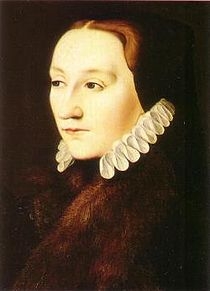

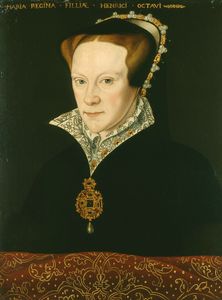



Above is a gallery of the major historical characters in the novel: Lady Katherine Grey; Frances Brandon, Duchess of Suffolk (?); Lady Jane Grey, as depicted by Paul Delaroche; Queen Mary I; Queen Elizabeth I; King Richard III; the still on the right shows Claire Bloom as the Lady Anne in the film Richard III, there being no portrait of Anne Neville.
A DANGEROUS INHERITANCE: THE HISTORY BEHIND THE FICTION
by ALISON WEIR
The Tower of London, 1562. At a time when Queen Elizabeth I sat insecurely on the English throne, a young woman of twenty-two was arrested and imprisoned. She was the Queen`s cousin, and she had dared to marry her lover secretly and produce a child who might live to challenge Elizabeth`s title. The question on everyone’s lips was: would the Queen demand the dread penalty for treason?
This hapless young woman was Lady Katherine Grey, and in her short life she had already suffered more than her fair share of tragedy. Eight years before, her older sister, Lady Jane Grey, had been beheaded for treasonously, if unwillingly, accepting the English crown and reigning unlawfully for nine days. Katherine was a victim of Jane`s fall, for her brief but happy first marriage, to Henry, Lord Herbert, was speedily dissolved; his father did not want his line tainted by association with a traitor. He had not even allowed the young couple to consummate their union, envisaging, correctly, that things might go very wrong for those who had put Lady Jane on the throne.
Katherine felt the parting from her husband keenly, and for many years she hoped that they might be reunited, but it was not to be. Then she met Edward Seymour, nephew of Queen Jane Seymour, and fell in love headily - and disastrously. For many regarded Katherine as the rightful heir to Elizabeth`s throne, and the Queen was jealous: she would not tolerate a rival, or allow Katherine to marry. But Katherine defied her, and when her pregnancy could be concealed no longer, she found herself a prisoner in the Tower.
A Dangerous Inheritance is a novel based on Katherine’s life, and researched from contemporary sources. In telling her story, I have adhered to the known facts, although I have taken a little dramatic licence, all explained in the Author’s Note at the end of the book. There are quotes from contemporary documents, and the letters are genuine. Archaic language has been modified to blend in with a modern text, although I have made use of many contemporary idioms.
The course of Katherine’s courtship by Edward Seymour, and his sister’s role in it, was much as it is portrayed in the novel, and the account of their wedding day – and ‘night’ – is based closely on their own depositions. Katherine’s love for Edward was the overriding passion of her life, and she remained staunchly faithful through every trial, until her death.
Katherine is not the only heroine in this book. She is linked by marriage and (in the novel) supernatural ties, to a girl who lived eighty years earlier, and whose true story is lost in the mists of time.
Katherine Plantagenet, the bastard daughter of King Richard III, is known to history only through four grants relating to her marriage to William Herbert, Earl of Huntingdon in 1484, and the financial settlements relating to it. From this and from circumstantial evidence and credible inference, Alison Weir has woven a fictional tale around her. Thus the story flashes back nearly eighty years, to 1483, when thirteen-year-old Kate Plantagenet is brought to London for Richard’s coronation. Kate loves her father, and she has been well-treated by his Queen, Anne Neville, in whose household she has been reared with her two half-brothers, Edward of Middleham, Prince of Wales, and John, the Bastard of Gloucester – all historical figures.
But all is not well at court, and soon after her arrival, Kate senses sinister undercurrents. Her father has gained his throne by disinheriting and deposing his nephew, the young King Edward V, and has imprisoned the former King and his brother in the Tower of London. Before long, Kate hears terrible rumours that King Richard has had the two Princes in the Tower murdered. This throws her into turmoil. Like many at the time, and since, she wants to know the truth about the Princes’ disappearance.
Writing about Richard III from the viewpoint of a daughter who wanted to believe the best of him proved a challenging experience, because in 1992 I published a book entitled The Princes in the Tower, in which I investigated the ancient but still highly controversial mystery of their disappearance, and concluded that strong evidence pointed to Richard III having ordered their murder. Do I revise my conclusions in this novel? You’ll have to read it to find out.
The fictional Kate resolves to discover the truth, hoping that she will be able to prove that her father has not shed the blood of innocents. And so she embarks on what will prove to be a dangerous quest. But time is not on her side.
Meanwhile, in the Tower, Katherine Grey becomes increasingly perturbed by eerie dreams and phantom voices, and wonders if these manifestations are somehow related to the disappearance of the Princes in this very fortress eighty years before. Katherine’s interest in the mystery is emotional, bound up with her fears for her baby son, who is too near in blood to the throne for comfort – just like the Princes. And so, with the help of her kindly gaoler, Sir Edmund Warner, she too sets out to find the truth. The two girls’ quests are pure fiction, but the evidence they uncover is based on fact, although I had to take into account which sources would have been available to them in 1483-5 and 1562.
Historically, Sir Edward Warner was a sympathetic custodian. He allowed Seymour to visit Katherine in the Tower, with the result that she fell pregnant again. Time was not on her side either.
There is a third prominent female character in the novel: Elizabeth I. If Elizabeth was Katherine’s bête noir, Katherine was hers – and with good cause, for Elizabeth had compelling reasons for fearing the woman whom many regarded as her legal successor. One can feel sympathy for both women, but my Elizabeth is a more menacing character, reminiscent of her grandfather, Henry VII. The Interludes in the book are there to show Elizabeth’s point of view; without them, she comes across as a cruel persecutor.
The fictional Kate’s pendant is modelled on the famous Middleham Jewel. The bundle of papers tied up in a ribbon is, sadly, an invention.
A constant theme in the novel is the danger of being too close in blood to the throne. Under the Act of Succession, Lady Katherine Grey was Elizabeth I’s heir, but Elizabeth was paranoid about naming her successor, for fear of forming a faction that would plot against her. Thus Katherine was damned in Elizabeth’s eyes from the start. Elizabeth would not allow her to marry because she feared that her husband would press her claim to the throne, and that any son she bore would be seen as preferential to a female ruler. Katherine’s folly in marrying secretly for love, and producing two sons, was anathema to the Virgin Queen, who denied herself the comforts of marriage for political and, probably, psychological reasons.
It is possible that Katherine’s head was so turned when she saw her sister made queen that for ever after her ambitions were focused on wearing a crown. This is the only theory that makes sense of her behaviour. In my view, she was not a would-be traitor but a self-obsessed girl who let her heart rule her head and did not think things through logically. Her instincts were emotional rather than rational. Because of that, she ended up out of her depth, in deep trouble.
It is unlikely that Katherine wanted to supplant Elizabeth; rather, she wished to be acknowledged as her successor. William Cecil’s enquiries persuaded him that Katherine’s union with Seymour was no more than a love match – he called it ‘that troublesome, fond matter’ – and not part of a plot against Elizabeth, yet whatever his private feelings, he followed the Queen’s lead in punishing the couple.
The fictional Kate Plantagenet finds her kinship with Richard III a threat to Henry VII, the man who overthrew him, and to her husband, who no longer wants to be married to the daughter of a king who has been branded a usurper and murderer. Continuing the theme, by their very existence, the historical Princes in the Tower remained a threat to Richard III after he declared them bastards and had Edward V deposed. Risings in their favour convinced him that he would never be secure on his throne while they lived. The historical Elizabeth I had grown up in the shadow of the Tower: her mother, Anne Boleyn, had been executed there for treason, as had others who were close to her; and she herself was imprisoned there in youth, expecting to be executed daily. Elizabeth too had known the stain of bastardy, and how easy it was to become the focus of others’ plots, which had been the fate of the executed Lady Jane Grey. All these women – Elizabeth, Jane and Katherine – endured danger and tragedy because of the royal blood that ran in their veins. For them all, it was a dangerous inheritance.

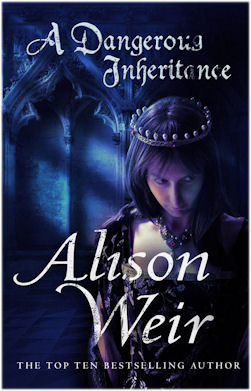
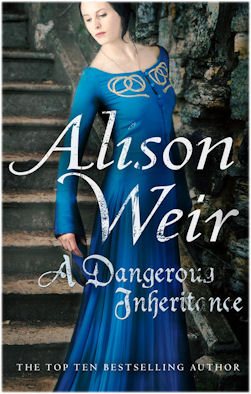
Above are the original UK jacket concepts for the book. They are not intended to be accurate in terms of costume and location, but to give an idea of the design and colour scheme.

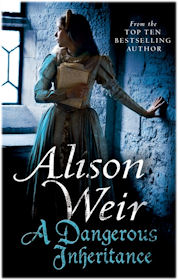
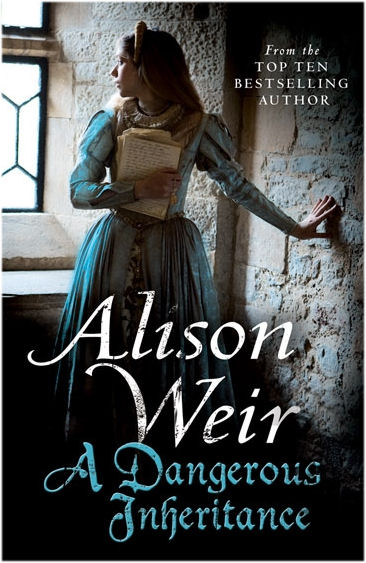
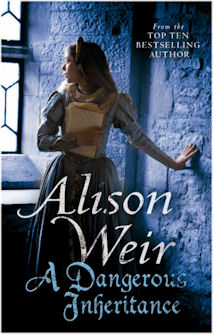
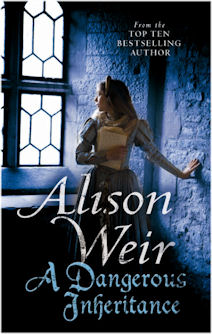
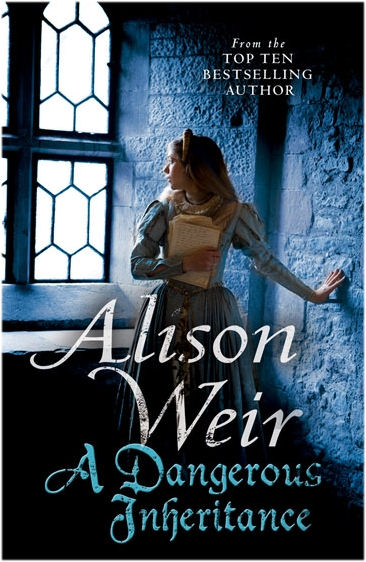

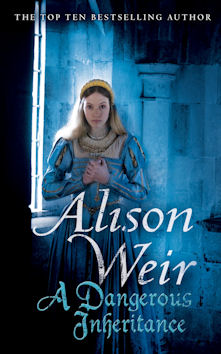
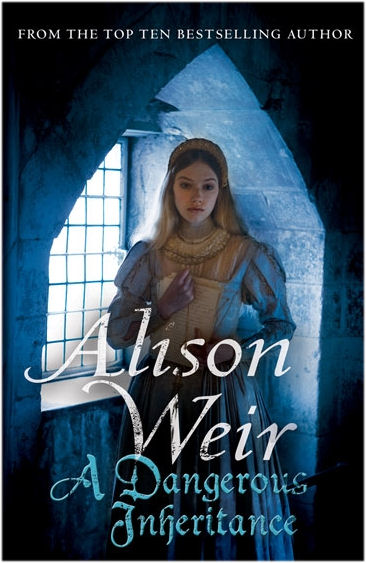

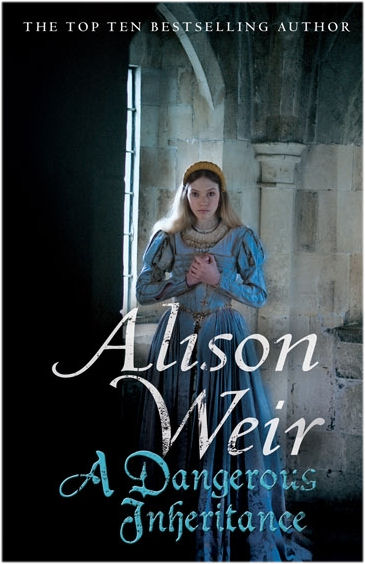
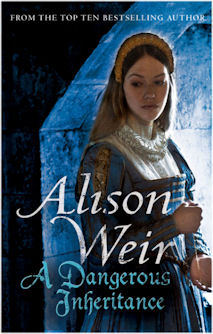
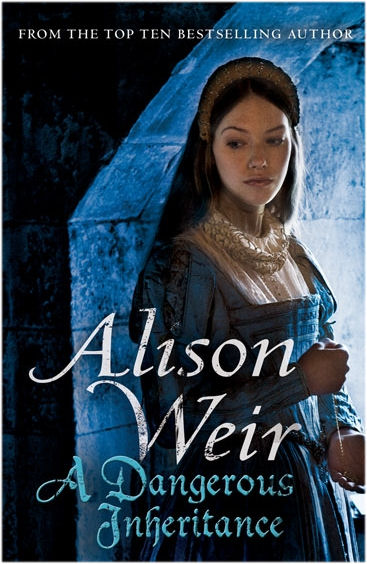
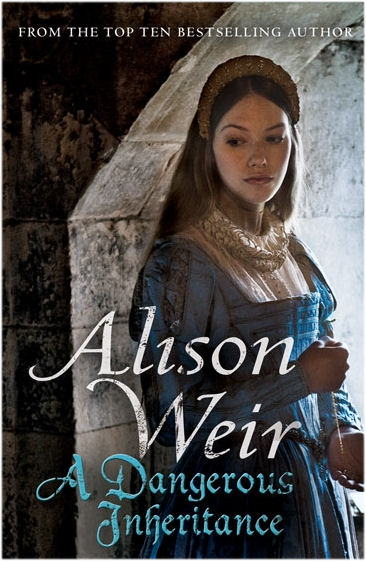
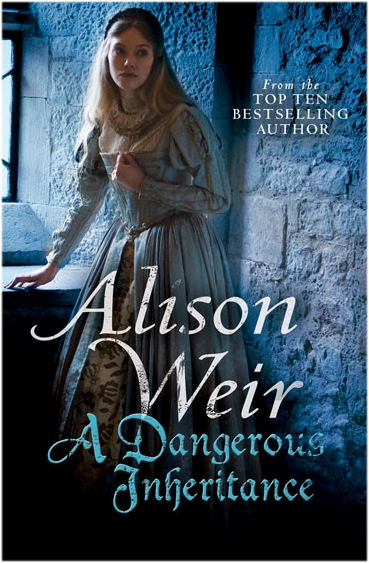
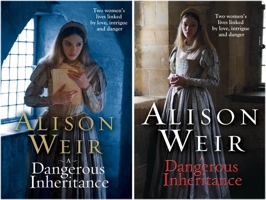
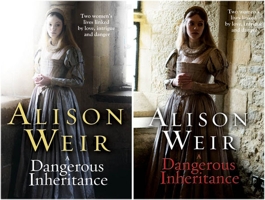

Above, and at the bottom of the page, are preliminary UK hardback and paperback (bottom two rows) jacket designs. The actual colour of the gown, which I chose myself at Angel's, the theatrical costumiers, is ivory.
I LAUNCHED A DANGEROUS INHERITANCE AT THE TOWER OF LONDON
Lorna Fergusson, author of The Chase, one of my favourite novels, was a guest at the launch, and has posted a blog about it at http://literascribe.blogspot.com. For more info about Lorna, go to www.fictionfire.co.uk. The Chase, a haunting mystery set in the Dordogne, a part of France I love and know well, was reissued as an e-book in the autumn.
The launch party for the book was held at Cheyneygates, the fourteenth-centry former abbot's house in Westminster Abbey, and the oldest house in London.
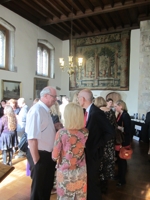
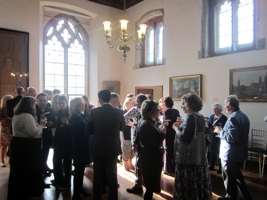
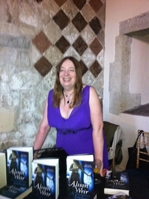
I gave this speech about the house:
"You are standing in a very important and historic house, the oldest house in London, which dates from the fourteenth century. Cheyneygates is the former house of the pre-Reformation abbots of Westminster, and it has been the setting for momentous historical events. Enter these rooms, and you are treading in the footsteps of kings, queens and great men.
In 1470, during the Wars of the Roses, when King Edward IV was exiled, his queen, Elizabeth Wydeville, fled into sanctuary in the Abbey with her three young daughters, the eldest of whom was Elizabeth of York, the future queen of Henry VII and mother of Henry VIII. The kindly Abbot Mylling could not allow the Queen to rub shoulders with felons and thieves in the common sanctuary building that occupied the site of Middlesex Guildhall, so he kindly accommodated her and her children in this, his palatial house, where she was very royally housed. In November that year, a king was born here, the prince who would become Edward V, the elder of the ill-fated Princes in the Tower.
Edward IV returned in triumph the following year, but when he died in 1483, his widow, Elizabeth Wydeville, sought sanctuary here in Cheyneygates yet again, fearing the ambitions of Richard of Gloucester, the future Richard III. This time, she came accompanied by her five daughters and younger son, Richard of York, plus a huge amount of baggage – so much that a wall had to be taken down to get it all in. The Abbot’s response in not recorded. Her elder son, the young King Edward V, was lodged in the Tower, and much pressure was put on the Queen to allow the younger boy, York, to join him there. It was here, on 16th June 1483, that she reluctantly let him go. The Princes in the Tower disappeared just a few weeks later.
In 1486 Cheyneygates was leased to Elizabeth Woodville, although she only lived there for a few months. Her son-in-law, Henry VII, often dined here with Abbot Islip, and was served the Abbey’s famed marrowbone pudding. In 1509, Henry’s mother, the formidable Margaret Beaufort, died in Cheyneygates; and it was in these rooms, in 1534, that Sir Thomas More was kept in custody before his removal to prison in the Tower.
After the Reformation the Abbot’s House became the Deanery and in the 19th century Cheyneygates was used as the Dean’s study. In 1941, however, the Deanery and Cheyneygates were badly damaged. The rooms were subsequently reconstructed. These are the only ones to which the public may enjoy privileged access. The famous Jerusalem Chamber, where Henry IV died in 1413, is now part of the Deanery, which is private.
Westminster has a special resonance for me. I was born at St Thomas’s, just across the Thames, and spent my childhood in a fine mansion flat opposite County Hall. Big Ben chimed its way through my formative years. So I always feel, when I come to Westminster, that I am coming home."
A DANGEROUS INHERITANCE
by ALISON WEIR
Article written for the Daily Telegraph, 2012
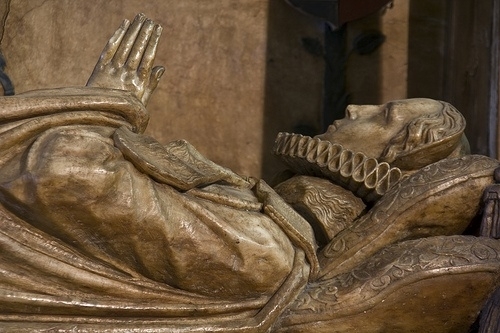
Tomb effigy of Lady Katherine Grey in Salisbury Cathedral
In this Jubilee year, the royals are at their most popular, and even a year on from William and Kate’s wedding, all eyes are still on the heirs to the throne, who visibly bask in the Queen’s approval. But it wasn’t always this way – and this is the main theme of my new novel, A Dangerous Inheritance, which tells the story of two young women who lived in an age in which royal heirs who were perceived as a threat to the monarch were swiftly dealt with. The two female heroines, Lady Katherine Grey and Katherine Plantagenet, are linked in more ways than one, but mainly because they are both in danger for being too close in blood to the throne.
Katherine Grey was cousin to Queen Elizabeth I. In 1562, at a time when Elizabeth’s throne was by no means secure, Katherine dared to marry in secret and produced a child who might live to challenge the Queen’s title. Inevitably, she ended up in the Tower, in peril of death.
Katherine had already suffered tragedy. Eight years before, her older sister, Lady Jane Grey, had been beheaded for treasonously, if unwillingly, accepting the English crown and reigning unlawfully for nine days. Katherine was a victim of Jane`s fall, for her brief but happy first marriage, to Henry, Lord Herbert, was speedily dissolved; his father did not want his line tainted by association with a traitor. He had not even allowed the young couple to consummate their union, envisaging, correctly, that things might go very wrong for those who had put Lady Jane on the throne.
Katherine felt the parting from her husband keenly, and for many years she hoped that they might be reunited, but it was not to be. Then she met Edward Seymour, nephew of Queen Jane Seymour (Henry VIII’s third wife), and fell in love headily - and disastrously. For Katherine was the heir to Elizabeth`s throne, and the Queen was jealous: she would not tolerate a rival, and had forbidden Katherine to wed. Katherine’s folly in marrying secretly for love, and producing a son, was anathema to the Virgin Queen, who denied herself the comforts of marriage for political and, probably, psychological reasons. But Katherine’s love for Edward was the overriding passion of her life, and she was to remain staunchly faithful through every trial, until her death.
Katherine Grey’s tale is interwoven with that of a spirited, beautiful girl who lived eighty years earlier. The two are linked by marriage and (in the novel) supernatural experiences.
Katherine Plantagenet, the bastard daughter of King Richard III, is known to history only through four grants relating to her marriage to William Herbert, Earl of Huntingdon. From this and from circumstantial evidence and credible inference, I have recreated her story. Thus the narrative flashes back eighty years, to 1483, when thirteen-year-old Kate Plantagenet is brought to London for Richard’s coronation. Kate loves her father, but soon after her arrival at court, she senses sinister undercurrents. King Richard has gained his throne by disinheriting and deposing his nephew, the young King Edward V, and has imprisoned the former King and his brother, the Duke of York, in the Tower of London. Before long, Kate hears appalling rumours that her father has had the two Princes in the Tower murdered. This throws her into turmoil: Like many people at the time, and since, she wants to know the truth about the Princes’ disappearance.
Writing about Richard III from the viewpoint of a daughter who wanted to believe the best of him proved a challenging experience, because in 1992 I published a book entitled The Princes in the Tower, in which I investigated the ancient but still highly controversial mystery of their disappearance, and concluded that the evidence strongly suggests that Richard III did order their murder. In this novel, my aim was to present him in a more positive light, through the eyes of the daughter who loved him.
Hoping that she will be able to prove that her father has not shed the blood of innocents, Kate embarks on what will prove to be a dangerous quest. But time is not on her side.
Meanwhile, in the Tower, Katherine Grey becomes increasingly perturbed by eerie dreams and phantom voices, and wonders if these manifestations are somehow related to the disappearance of the Princes in this very fortress, eighty years before. Katherine’s interest in the mystery is emotional, bound up with her fears for her baby son, who is too near in blood to the throne for comfort – just like the Princes. And so, with the help of her kindly gaoler, Sir Edmund Warner, she too sets out to find the truth. The evidence the two girls uncover is based on fact, although I had to take into account which sources would have been available to them in 1483-5 and 1562.
Katherine Grey’s sojourn in the Tower was relatively comfortable. Warner was a sympathetic custodian and allowed Edward Seymour to visit Katherine, with the result that she fell pregnant again, with grievous consequences. Time was not on her side either.
A constant theme in the novel is the danger of being too close in blood to the throne. Katherine Grey was Elizabeth’s heir, but it’s unlikely that she wanted to supplant the Queen; rather, she wished to be acknowledged as her successor, which Elizabeth would not do. It is possible that Katherine’s head was so turned when she saw her sister Jane made queen that for ever after her ambitions were focused on wearing a crown. In my view, she was a naïve girl who let her heart rule her head and did not think things through logically. Her instincts were emotional rather than rational. Because of that, she ended up out of her depth, in deep trouble.
The fictional Kate Plantagenet is not Richard III’s heir, but after he is defeated at the battle of Bosworth by Henry Tudor, her kinship to the fallen monarch is a threat to the usurper, now Henry VII, and to her husband, who no longer wants to be married to the daughter of a king who has been branded a tyrant. Continuing the theme, by their very existence, the historical Princes in the Tower remained a threat to Richard III after he declared them bastards and had Edward V deposed. Plots in their favour convinced him that he would never be secure on his throne while they lived.
Elizabeth I had grown up in the shadow of the Tower: her mother, Anne Boleyn, had been executed there for treason, as had others who were close to Elizabeth; and she herself was imprisoned there at twenty, daily expecting to be executed for her suspected involvement in a rebellion to put her on the throne in place of her sister, Mary I. Elizabeth too had known the stain of bastardy, and how easy it was to become the focus of others’ plots, which had been the fate of the executed Lady Jane Grey.
Fortunately, we live in more enlightened times: the last royal to suffer execution was Charles I in 1649, and since Tudor times the succession to the crown has never been so disputed. Unlike Elizabeth I, Lady Jane Grey, the Princes and my two heroines, young royals today do not have to endure danger and tragedy because of the blue blood that runs in their veins. For them, mercifully, it is no longer a dangerous inheritance.
TALKING SHOP WITH NANCY BILYEAU!


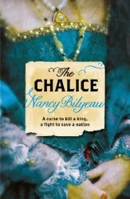
Nancy Bilyeau is the author of The Crown, a stunning debut historical novel set in Dartford Priory in the sixteenth century, and its sequel, The Chalice.
NB: I believe I’ve read every single one of your books and just finished your latest, A Dangerous Inheritance. After I read The Lady in the Tower, I was shaken, because it drove home to me as never before the pitiable tragedy of Anne Boleyn, and how abandoned she was by all after her husband turned on her. What’s interesting is that after I finished A Dangerous Inheritance, I felt disturbed, too, by how lost in their dangerous times these two women were, Katherine Grey and Kate Plantagenet. Was that one of your goals in writing the book, to illuminate how less well known women of that age could come to tragedy?
AW: Yes, it was. I am always interested in retrieving women’s histories, and I wanted to show how the constraints of noble birth, royal blood and gender could impact on young girls.
NB: Did you become intrigued by Katherine Grey while researching Lady Jane Grey for your novel and earlier books and decide to tell her story as well? And how different she was from her sister!
AW: I became intrigued years ago when I read Two Tudor Portraits by Hester W. Chapman. I wrote Katherine’s story in Elizabeth the Queen, but not in any great depth, but I knew enough of it to know that it was a very dramatic tale – and a tragic one. She was very different from Lady Jane Grey: she was beautiful where Jane was plain, placid where Jane was feisty; she was no bluestocking or formidably learned, as Jane was, and in some ways she comes across as lacking in common sense and forethought, but one cannot but feel sympathy for her.
NB: What do you think of the current theory that Frances Brandon was not as abusive to her daughter Jane Grey as historically assumed? She is a complex figure in your book.
AW: I don’t buy it! We have Jane’s own testimony and other evidence. But maybe Henry Grey was even more unpleasant!
NB: Elizabeth I is known to have disliked Katherine Grey and refused to name her heir even before the scandalous marriage and pregnancy. Do you think the dislike was at all justified and would Katherine Grey have made a good queen of England in the 16th century?
AW: Katherine’s own behaviour – her failure to convert back to the Protestant faith and her flirtations with Spain – was not conducive to Elizabeth thinking kindly of her, but Elizabeth was pretty paranoid about anyone with a claim to the succession, so Katherine was damned from the start. She was pretty and she was younger than the Queen – red rags to a bull! – and she acted very rashly in marrying Edward Seymour. It undermined Elizabeth’s policy, threatened her throne, and must have been galling to a queen who rejected marriage for political – and probably psychological – reasons. Katherine did not have what it took to be a queen, neither the brains nor the resolve. She lived in a fantasy world. I can understand why Elizabeth was harsh with her – and in many ways I think it was justified.
NB: How much is known about Kate Plantagenet? Was it more challenging or more interesting to develop her character and plot, since there is less documentation of her life than Katherine Grey’s?
AW: She is mentioned in only four documents – a gift to any novelist, as her life is a blank canvas. But I knew the context of it, as I’ve studied Richard III’s reign over many years. I had to rely a lot on detective work, inference and probability.
NB: Why did you decide to tell their stories in one book, and not write a book on each of them?
AW: The idea for the book evolved gradually. It was originally going to be based on the premise that Perkin Warbeck really was Richard, Duke of York, but I couldn’t make that work, given the source material and the flimsy premise on which he based his claim. I liked the idea of a mystery with a supernatural theme, possibly a timeslip. I wanted to find a new way in which to explore the fate of the Princes in the Tower, and I needed a love story to replace that of Perkin Warbeck and Katherine Gordon. I also wanted to write a sequel to Innocent Traitor. It occurred to me too that writing about Richard III from the point of view of the daughter who loved him would be a novel approach. Eventually, all these ideas came together – after many nights spent lying awake wondering how to meld them!
NB: The character and actions of Richard III loom very large in this book. He fascinates, if not obsesses, people of that time. And
couldn’t it be argued, with the archaeological dig in Leicester, that he fascinates us today? Why is that?
AW: People love a mystery, and they also love conspiracy theories. Yes, Richard fascinates – and many become obsessed, which concerns me. As a historian, I feel I must be objective and not emotionally involved. There is a lot of compelling circumstantial evidence that Richard had the Princes murdered, and that he was a ruthless operator. If there was convincing evidence to counteract all that, I would go with it. But nothing I have read has changed my view.
NB: Do you think that they did indeed discover the body of Richard III this year?
AW: It’s too early to say. The body was in the right place, the scoliosis ties in with the (hostile) descriptions of Richard, and the wounds could be consistent with those he received at Bosworth. I await the DNA results eagerly.
NB: Your view of Henry VII and Margaret Beaufort was not positive in the novel. Have you always thought of them in this way or did research for the book form newer evaluations?
AW: Some see Henry VII as a Machiavellian ruler; it’s trendy nowadays to view Margaret Beaufort as sinister. Historically, I take a different view, but this was fiction, and they are seen from the point of view of Richard’s daughter, so naturally she would find them menacing.
NB: In this novel, you make the women’s behavior consistent with that time, and not necessarily our own. In some historical fiction written today, a 13-year-old girl who wanted to consummate her marriage would be treated as an abused victim but you did not make that choice. Was it difficult to write that part of the book?
AW: No, I just wanted to portray things as they were. Girls were permitted by the Church to be married in childhood and to cohabit at twelve. Life was shorter then. But I was very much aware of modern sensibilities on the subject, and you may have noticed that there are no overtly sexy scenes involving characters that we would deem under-aged.
NB: Can you tell us about your next book?
AW: It’s a biography of Elizabeth of York, and it’s nearly finished. I’ve really enjoyed this project, and have made some surprising discoveries.
STANDFIRST: A DAY OFF SCHOOL FOR AUTHOR AND HISTORIAN ALISON WEIR CHANGED THE COURSE OF HER LIFE
From the University of York's magazine, 2011
When historian and author Alison Weir ‘graduated’ from reading books to reading comics in her early teens, it infuriated her mother. Such was the maternal displeasure that, despite being off sick, the 14-year-old was marched from a doctor’s waiting room to a nearby public library and instructed to ‘take out a book’. But the historian and author, who visited the University recently to deliver a public lecture on Queen Elizabeth I, still remembers that day with fondness, because it was the moment she acknowledges that her life changed forever. When Weir entered that library, she ignited a passion that burns to this day.
She emerged with a spicy for its time - it was the mid 1960s - volume called Henry's Golden Queen, a romantic novel about Katherine of Aragon. It was not perhaps the choice of reading matter her mother had in mind, but it had the desired effect. Comics were forgotten and though Weir says the book was trashy, it was a book – and it was about history.
“It was an adult novel and I simply devoured it,” she says. “It was pretty racy and I thought to myself, ‘Did they really go on like that in those days?’ My passion for history was born overnight and I just wanted to find out more and more.”
Within a year she was researching and writing feverishly - histories, reference works, family trees, plays and novels - but it would be years before she saw any of her efforts in print. Weir studied history at college and trained as a teacher, and then raised a family. Throughout, history was her hobby and she continued writing about it. But she saw little or no chance of escape from her civil service job – the repeated rejection slips from publishers had taken their toll. She admits to being ‘completely demoralised’.
“I kept going for personal enjoyment, and then suddenly I got into print and you could have knocked me down with a feather,” she says.
The years of painstaking research in reference libraries, transcribing chronicles and calendars had finally paid dividends. The result, in 1989, was Britain’s Royal Families and it was based on research that she had started in her teens.
Weir has never looked back and she has now written 15 popular histories while her three novels are all based on historical themes. Both her fiction or non-fiction output rely on extensive research.
“I love the research because you never know what it’s going to throw up. I don’t have expectations – I just clear my mind of any previous ideas about the subject and see where the sources take me,” she says.
The sheer scale of her research is impressive by any measure, but the popular histories that ensue have resulted in criticism in some academic quarters that she is a lightweight. But Weir defends her narrative approach as entirely legitimate.
“I admire academics immensely. Where would we be without them? But I don’t like the occasionally sniffy attitude that a few of them have towards people like me,” Weir says. “There’s no doubt that there’s a certain competitiveness in the historical field, but every book is a contribution to the debate and after all, we all use the same source material. We just present it in different ways.”
Weir’s decision to branch out into writing historical novels “as a sideline” has been an entertaining diversion, though it has also meant that she has had to learn some new skills. Every book, she says, represents a learning curve. Nevertheless, she regards herself first and foremost as a historian.
So what is next? Her next novel - A Dangerous Inheritance - centres on the story of Lady Katherine Grey, the sister of Lady Jane Grey, with a subplot about the Princes in the Tower.
She is also writing a biography of Elizabeth of York, the sister of the Princes in the Tower, who was a pivotal figure at the end of the Wars of the Roses. After the Battle of Bosworth Field and the death of Richard III, Henry VII married her to consolidate his claim to the throne.
York is not unfamiliar territory to Alison – the late Ron Weir, doyen of the Department of History and Provost of Derwent College, was her brother-in-law. She attended a private event in Derwent during her recent visit.
“We have been coming up to York for holidays since my kids were small when we used to housesit for Ron and Alison. It’s a lovely city and I never tire of it.”
INTERVIEW FOR 'THE LADY', U.K., 2012.

What inspired you to study history, and your particular interest in the Tudors?
When I was fourteen, my mother marched me into a library and said, ‘Get a book.’ I chose my first adult novel, Henry’s Golden Queen by Lozania Prole, and devoured it in two days. As historical fiction it was trite, but it sent me off to the history books to find out what really happened – and I’ve been trying to find it out ever since.
As a former teacher, how do you feel about the way history is taught in schools?
I am appalled at the way history is taught in schools. When I was running my own school in the nineties, I realised that textbooks were being dumbed down, and that inaccuracies were common. There seems to be an aversion to teaching pupils the overall sweep of our history. How can you understand the Tudors if you haven’t studied the Middle Ages? And why do educationists fight shy of monarchs, dates and prominent historical figures? We need to know the political framework as well as the social history.
What makes for a good historian?
A good historian approaches their subject objectively, having cleared their mind of all previous perceptions. They trawl exhaustively through original sources evaluating each judiciously. Only then will they look at secondary sources and assess what other historians have written. All historians study the same sources: the fact that history is presented in a ‘popular’ way does not make it less authentic.
Tell us about your next book.
My next book is a novel entitled A Dangerous Inheritance. It tells the stories of Lady Katherine Grey, who was imprisoned in the Tower of London in 1562 by her cousin Elizabeth I; and of Kate Plantagenet, the bastard daughter of King Richard III. Katherine and Kate find out that incurring the wrath of princes is a dangerous game, and that being near in blood to the throne is a curse rather than a blessing. Both young women risk much for love, and to uncover the truth - and both court a tragic fate.
INTERVIEW WITH ALISON WEIR
by Helen Greenwood. Edited and corrected version.
(The Sydney Morning Herald, July 2012)
The acclaimed author, who fell in love with history as a teenager, is dedicated to pursuing the truth.
Alison Weir is the No.1-selling female historian in Britain. She has sold more than 2.3 million copies of books on famous figures that include a virgin queen, a serial-marrying monarch and a scandalous duchess. Weir's sales rank her as Britain's fifth biggest-selling historian behind Antony Beevor, Stephen Ambrose, Simon Schama and Peter Ackroyd.
Weir is also down-to-earth, maternal, and laughs as delightedly as a first-time author when I tell her that three generations of women in my family enjoy her books. ''Three people in one family, it's fantastic,'' she says. ''It gives me a huge buzz when people say they've enjoyed my books, because this grew out of a hobby and it's an absolute passion, and it's lovely when I get feedback.''
Weir's passion was ignited when her mother, concerned about her daughter's comic-book reading habits, marched the 14-year-old into a library. Weir randomly plucked out a racy read about Katherine of Aragon - and was hooked.
''I devoured it in two days,'' Weir says. ''For the time, it was rather naughty, and my family was quite straight-laced about those sort of things. I thought, 'Did they really go on like that in those days?' and rushed off to the history books to find out.''
The teenager found the Tudors so compelling she started writing her own history books and then trained as a history teacher. She amassed a home library and filing cabinets filled with research.
She wanted to turn her hobby into a career but her first effort, The Six Wives of Henry VIII, was rejected in 1974 as too massive. ''I got very demoralised because I'd put my heart and soul into it. It was far too long, I know now, but I was very naive then. I did a lot of projects after that and never finished them, but I've still got all the research and I've used a lot of it.'' Weir is not one to give up easily, though, and thought she would have a final try.
Britain's Royal Families was published in 1989 when she had two children and was teaching them at home. Her son had a learning disability and, because the local schools could not cater for his needs, she later set up a private school in her garage for him and others like him. At the same time, she wrote Lancaster and York: The Wars of the Roses (1995), Children of England: The Heirs of King Henry VIII (1996), Elizabeth the Queen (1998) and Eleanor of Aquitaine (1999). In the past 23 years, she has written 15 popular histories. ''It's a passion,'' she says.
In 2007 she published her first historical novel. Her fourth, A Dangerous Inheritance, is out this month. Like many of her books, it's about women's lives. ''I'm interested in retrieving them from the obscurity to which they've been consigned until recently.
''When I started researching history in the 1960s, a lot of women about whom I've subsequently written were actually footnotes to history. There was a perception that women weren't important. And it's true, women were seen historically as far inferior to men. It's only in very recent times that women have become emancipated, and it's interesting to be able to focus on them at last, because they were virtually ignored unless they were famous, like Elizabeth I or Eleanor of Aquitaine.''
In A Dangerous Inheritance, the heroines aren't famous but have fascinating stories. One is Kate, the illegitimate daughter of Richard III. The other is Katherine Grey, the sister of the ill-fated Lady Jane Grey, who was England's queen for nine days.
The two Katherines are linked by history's most famous unsolved mystery, the disappearance of the young Princes in the Tower, and by having forbidden lovers.
A Dangerous Inheritance is Weir's most ambitious historical novel to date. Though it stands alone, it can be read as a sequel to her first novel, Innocent Traitor, the tragic story of the accomplished Lady Jane Grey, propelled to the throne after the death of Henry VIII's son, Edward.
The Tudors have gripped our imagination for centuries and Weir is no exception. She gives talks and takes tours and explains why that period fascinates her.
''These are are larger-than-life, dynamic characters about whom we have a lot of information, and there are dramatic events,'' she says. ''There are six [royal] wives, two of whom are executed. There are three annulments, a queen for nine days who is beheaded at the age of 17, and you've got the first female ruler as well.''
The spread of literacy during Tudor times left a rich historical legacy. ''We have this incredible, documented record of royal private lives that fleshes out the characters and makes them become so real,'' Weir says. ''We also have an incredible visual record, for example, the portraits of Hans Holbein, so we can see for the first time what people really looked like.''
Then there are the remains of those splendid palaces dotted throughout England. ''It's an age of magnificence. Power attracts, power is sexy, and these are the outward manifestations of power. It's very, very exciting. There's so much documentation of this period, so much visual evidence.''
Understandably, she gets peeved when books and films and television dramas get the facts wrong. But does it really matter that there is the wrong kind of costume in the top-rating, sexy TV series The Tudors, or the wrong kind of dog in the lovingly dramatised Elizabeth: The Golden Age?
''I don't think it matters that there is the wrong kind of dog,'' Weir says. ''What matters is when they get the really big things wrong. Sir Walter Raleigh, as played by Clive Owen, for example, [defeating] the Spanish Armada almost single-handedly when he wasn't even there. I was asked to review it by The Guardian and I took my mother, who is a film buff. She had to tell me to shut up and stop laughing.''
Film is a powerful medium and people learn to accept errors as facts, she says. ''The first Elizabeth film was an absolute travesty historically. It really was sloppy. As for The Other Boleyn Girl and The Tudors, people's perceptions are distorted because of these. It matters to me as a historian, because I spend my life trying to get it right, although I don't get it right on every occasion. When we see a very romanticised view of Henry VIII's wives, this is seen as history, and so it becomes history.''
By comparison with the well-documented Tudor period, she says, the mediaeval era is harder to write about. ''Right at the end of it, you get the invention of printing but we haven't got the documentation about the private lives of monarchs. We've got some, but nowhere near the extent we have about the Tudors.''
As a historian, Weir has successfully overcome these obstacles. It took eight years for her to convince her publishers she could produce her brilliant biography of Eleanor of Aquitaine. ''They said, 'How can you write a biography on a woman who has been dead for 800 years in the same way you can write one on the wives of Henry VIII or Elizabeth I?'
''There is the source material, but it's more fragmentary. It's a different kind of biography. I put forth the evidence and try to infer what I can from it. Beyond that, you're in the realm of speculation.''
Taking a stab in the dark is second nature to Weir, who was a dreamy child with a vivid imagination that used to get her into trouble. ''I'd scare myself a lot. I used to read ghost stories, I was fascinated by them, and I knew they'd frighten me and of course there I was at night wailing and my mother saying, 'You're not reading them' when she found them.
"I'm still very imaginative but when one writes history, one has to keep within the confines of historical research.''
These restrictions made her itch to get inside the heads of her subjects and write historical fiction. ''Having the freedom to think about their motives, emotions, reactions and how they got from A to B is liberating,'' she says. ''But there are still constraints because what they do and what they say must be in the context of what is known about them historically.''
After all these years, Weir is still the teenager who fell in love with history. ''If people really want to know and learn from history, why do they want bad history? Why don't they want good history? Wouldn't you prefer to know the truth, rather than the legend?''
The Booktopia Book Guru asks Ten Terrifying Questions (2012)

(Alison Weir on the Lancaster and York Tour 2013)
To begin with why don’t you tell us a little bit about yourself - where were you born? Raised? Schooled?
I was born and raised in London, U.K., and educated privately, but my interest in history stems from independent study, although it was my specialist subject at teacher training college.
What did you want to be when you were twelve, eighteen and thirty? And why?
At twelve, a ballet dancer, because I was in love with the romance of it. At eighteen, a teacher – I’ve always loved working with children. At thirty, I wanted to be a mother and a published author, in that order.
What strongly held belief did you have at eighteen that you do not have now?
Too many to mention! I was a very opinionated teenager.
What were three works of art – book or painting or piece of music, etc – you can now say, had a great effect on you and influenced your own development as a writer?
There are too many examples to mention, but three stand out. The book was Antonia Fraser’s Mary, Queen of Scots, which set a new standard in historical biography. The painting was the portrait of Anne Boleyn in London’s National Portrait Gallery – it intrigued me, much as Anne always has. The music was the Pavane la Bataille by David Munrow and the Early Music Consort of London, which instantly transported me back to the magnificence of sixteenth-century courts. Annihilating!
Considering the innumerable artistic avenues open to you, why did you choose to write a novel?
I was already a published historian. I’d written lots of novels when I was young, and wanted to see if I could still write one. I wrote it just as a leisure project, but quite liked it, so I showed it to my agent. That’s how I became a published novelist.
Please tell us about your latest novel…
A Dangerous Inheritance is the stand-alone sequel to Innocent Traitor, that first novel. It tells the story of two beautiful, tragic heroines, linked both by kinship and by supernatural bonds.
In her short life, Lady Katherine Grey has already suffered more than her fair share of tragedy. Eight years before, her older sister, Lady Jane Grey, was beheaded for unlawfully accepting a crown that was not hers. And Katherine suffered too, as a result of Jane`s fall... Now she has defied her cousin, Queen Elizabeth I, by marrying a man who is forbidden her.
Intertwined with Katherine's story is that of her distant kinswoman, Kate Plantagenet, the bastard daughter of King Richard III. In 1483, Kate is brought to London for the coronation of her cousin, King Edward V, and her world changes dramatically.
Kate loves her father, but all is not well at court, and soon after her arrival, she senses sinister undercurrents and hears terrible rumours that deeply disturb her. Soon, she embarks on what will prove to be a dangerous quest, covertly seeking information that can throw light on what would become one of history's most enduring mysteries. But time is not on Kate`s side - or Katherine's either.
Katherine and Kate find out that incurring the wrath of princes is a dangerous game, and that being near in blood to the throne is a curse rather than a blessing. Both young women will risk much to for love, and to uncover the truth - and both will court a tragic fate.
What do you hope people take away with them after reading your work?
A sense that they have read about authentic history in an authentic setting – and also that they will have enjoyed the experience and gained new perspectives.
Whom do you most admire in the realm of writing and why?
I admire many writers for many different talents. My favourite novelist is the late Norah Lofts, whose work I admire for the integrity of her writing, her characters, her insights, and the sinister undercurrents in her books. I own all her books, and it’s always a joy to re-read them.
Many artists set themselves very ambitious goals. What are yours?
To publish all the research I’ve done over the years. I’m near to achieving that goal.
What advice do you give aspiring writers?
Never give up!
BRITISH WEEKLY INTERVIEW, U.S.A., 2012
When did you get the idea for your book? How did you get the idea?
I had long wanted to write about Lady Katherine Grey, whose story is so poignant, but I wanted to add a twist to the story – and I wanted to include a mystery with a supernatural element. The Tower of London provided inspiration, as Katherine was imprisoned there; and her story called to mind that of the Princes in the Tower, who had probably been murdered there eighty years earlier on the orders of Richard III. I thought about ways to approach that subject, and it occurred to me that there were parallels between Katherine Grey’s story and that of Richard’s bastard daughter, Katherine Plantagenet. Hence my two storylines – the entwined tales of these two tragic girls, each of whom have good reason to need to discover what really happened to the Princes.
What's the most surprising or unexpected thing that happened while writing or promoting this book?
Sir Thomas More, who wrote a controversial book about Richard III, and described how the Princes were suffocated on his orders, probably obtained much of his information from several ladies living in the Minoresses’ convent (‘the Minories’) near the Tower. Decades later, in my novel, Katherine Grey tries to track these ladies down and find out what they knew. It was amazing to discover, when reading an old book on the Minories, that after the dissolution of the monasteries it had come into the possession of Katherine Grey’s father and that she had lived there for some years of her childhood. That was an exciting coincidence – one I had not thought to find – and a tangible link between my characters.
What research did you do for this book?
My novels have all been based on research I have done over many years, and I know the Yorkist and Tudor periods very well, but I had not written to any extent on Katherine Grey, so I did have to do some original research on her. As for Katherine Plantagenet, she is only mentioned in four sources, so her life is a blank canvas – a gift to a historical novelist. The fate of the Princes was the subject of my book, The Princes in the Tower, and I followed that closely for the chapters relating the heroines’ quests to discover their fate.
If you viewed documents where did you go and how did you find them?
A lot of the sources I use are in print or online now, but I have researched from documents in the National Archives, the British Library or local archive offices.
What other books or other writing have you done?
Next year I’ll be publishing my twentieth book, a biography of Elizabeth of York. Sixteen of those books are non-fiction, mostly on kings and queens or women’s histories.
Have you won any awards for this book or other books?
My biography of Eleanor of Aquitaine won the U.K. Good Book Guide award for the best biography of 1999, as voted for by readers in 100 countries.
Who’s your editor?
Susanna Porter is my commissioning editor at Ballantine.
What's the most challenging part for you working with your publisher?
Not being able to get together with her to discuss the editorial process as often as I would like, as I value her advice and her creative input. But I’m in London and she’s in New York. It’s always a pleasure to get together and bounce ideas off each other.
How did you meet them and what's their editorial process?
I first met Susanna when she came to London and we had tea together. I liked her enormously, and have enjoyed working with her over the years. I’ve always had a strong sense that she really cares about my work. She is always very supportive. She and my U.K. editor pool their ideas on each new book, then my U.K. editor and I get together to discuss them. I do whatever is agreed, then Susanna may come back with further suggestions. The copy-edit is done in the U.K. as well, but I usually get a short list of queries from Ballantine to ensure that the book meets the requirements of the American market.
Who’s is your agent?
Julian Alexander of Lucas Alexander Whitley in London. He’s been my agent for twenty-five years now, and I can only say that I made a very good choice!
How did you find your agent?
I was recommended by a publisher who rejected a book but thought that my work had potential.
What are you currently working on now?
A biography of Elizabeth of York, queen of Henry VII and mother of Henry VIII.
Do you have a website? Twitter? Facebook? Upcoming book signings or events?
I have a website for my books – www.alisonweir.org.uk – and another for the historical tours I run: www.alisonweirtours.com, both of which I maintain myself. I use Facebook fairly regularly, and Twitter occasionally. As well as writing books and planning and leading tours (next year we’re running ‘Lancaster and York’ and ‘The Six Wives of Henry VIII’), I do a busy programme of events – I’ve had to cut them down from 67-69 a year to about 45, as I’m so busy. But I do enjoy them. I love meeting fellow history enthusiasts.
Is there anything else you'd like to add?
Just that I feel very lucky to be a published author, and that I’m still pinching myself!
A DANGEROUS INHERITANCE
by ALISON WEIR

In this Jubilee year, the royals are at their most popular, and even a year on from William and Kate’s wedding, all eyes are still on the heirs to the throne, who visibly bask in the Queen’s approval. But it wasn’t always this way – and this is the main theme of my new novel, A Dangerous Inheritance, which tells the story of two young women who lived in an age in which royal heirs who were perceived as a threat to the monarch were swiftly dealt with. The two female heroines, Lady Katherine Grey and Katherine Plantagenet, are linked in more ways than one, but mainly because they are both in danger for being too close in blood to the throne.
Katherine Grey was cousin to Queen Elizabeth I. In 1562, at a time when Elizabeth’s throne was by no means secure, Katherine dared to marry in secret and produced a child who might live to challenge the Queen’s title. Inevitably, she ended up in the Tower, in peril of death.
Katherine had already suffered tragedy. Eight years before, her older sister, Lady Jane Grey, had been beheaded for treasonously, if unwillingly, accepting the English crown and reigning unlawfully for nine days. Katherine was a victim of Jane`s fall, for her brief but happy first marriage, to Henry, Lord Herbert, was speedily dissolved; his father did not want his line tainted by association with a traitor. He had not even allowed the young couple to consummate their union, envisaging, correctly, that things might go very wrong for those who had put Lady Jane on the throne.
Katherine felt the parting from her husband keenly, and for many years she hoped that they might be reunited, but it was not to be. Then she met Edward Seymour, nephew of Queen Jane Seymour (Henry VIII’s third wife), and fell in love headily - and disastrously. For Katherine was the heir to Elizabeth`s throne, and the Queen was jealous: she would not tolerate a rival, and had forbidden Katherine to wed. Katherine’s folly in marrying secretly for love, and producing a son, was anathema to the Virgin Queen, who denied herself the comforts of marriage for political and, probably, psychological reasons. But Katherine’s love for Edward was the overriding passion of her life, and she was to remain staunchly faithful through every trial, until her death.
Katherine Grey’s tale is interwoven with that of a spirited, beautiful girl who lived eighty years earlier. The two are linked by marriage and (in the novel) supernatural experiences.
Katherine Plantagenet, the bastard daughter of King Richard III, is known to history only through four grants relating to her marriage to William Herbert, Earl of Huntingdon. From this and from circumstantial evidence and credible inference, I have recreated her story. Thus the narrative flashes back eighty years, to 1483, when thirteen-year-old Kate Plantagenet is brought to London for Richard’s coronation. Kate loves her father, but soon after her arrival at court, she senses sinister undercurrents. King Richard has gained his throne by disinheriting and deposing his nephew, the young King Edward V, and has imprisoned the former King and his brother, the Duke of York, in the Tower of London. Before long, Kate hears appalling rumours that her father has had the two Princes in the Tower murdered. This throws her into turmoil: Like many people at the time, and since, she wants to know the truth about the Princes’ disappearance.
Writing about Richard III from the viewpoint of a daughter who wanted to believe the best of him proved a challenging experience, because in 1992 I published a book entitled The Princes in the Tower, in which I investigated the ancient but still highly controversial mystery of their disappearance, and concluded that the evidence strongly suggests that Richard III did order their murder. In this novel, my aim was to present him in a more positive light, through the eyes of the daughter who loved him.
Hoping that she will be able to prove that her father has not shed the blood of innocents, Kate embarks on what will prove to be a dangerous quest. But time is not on her side.
Meanwhile, in the Tower, Katherine Grey becomes increasingly perturbed by eerie dreams and phantom voices, and wonders if these manifestations are somehow related to the disappearance of the Princes in this very fortress, eighty years before. Katherine’s interest in the mystery is emotional, bound up with her fears for her baby son, who is too near in blood to the throne for comfort – just like the Princes. And so, with the help of her kindly gaoler, Sir Edmund Warner, she too sets out to find the truth. The evidence the two girls uncover is based on fact, although I had to take into account which sources would have been available to them in 1483-5 and 1562.
Katherine Grey’s sojourn in the Tower was relatively comfortable. Warner was a sympathetic custodian and allowed Edward Seymour to visit Katherine, with the result that she fell pregnant again, with grievous consequences. Time was not on her side either.
A constant theme in the novel is the danger of being too close in blood to the throne. Katherine Grey was Elizabeth’s heir, but it’s unlikely that she wanted to supplant the Queen; rather, she wished to be acknowledged as her successor, which Elizabeth would not do. It is possible that Katherine’s head was so turned when she saw her sister Jane made queen that for ever after her ambitions were focused on wearing a crown. In my view, she was a naïve girl who let her heart rule her head and did not think things through logically. Her instincts were emotional rather than rational. Because of that, she ended up out of her depth, in deep trouble.
The fictional Kate Plantagenet is not Richard III’s heir, but after he is defeated at the battle of Bosworth by Henry Tudor, her kinship to the fallen monarch is a threat to the usurper, now Henry VII, and to her husband, who no longer wants to be married to the daughter of a king who has been branded a tyrant. Continuing the theme, by their very existence, the historical Princes in the Tower remained a threat to Richard III after he declared them bastards and had Edward V deposed. Plots in their favour convinced him that he would never be secure on his throne while they lived.
Elizabeth I had grown up in the shadow of the Tower: her mother, Anne Boleyn, had been executed there for treason, as had others who were close to Elizabeth; and she herself was imprisoned there at twenty, daily expecting to be executed for her suspected involvement in a rebellion to put her on the throne in place of her sister, Mary I. Elizabeth too had known the stain of bastardy, and how easy it was to become the focus of others’ plots, which had been the fate of the executed Lady Jane Grey.
Fortunately, we live in more enlightened times: the last royal to suffer execution was Charles I in 1649, and since Tudor times the succession to the crown has never been so disputed. Unlike Elizabeth I, Lady Jane Grey, the Princes and my two heroines, young royals today do not have to endure danger and tragedy because of the blue blood that runs in their veins. For them, mercifully, it is no longer a dangerous inheritance.
MINORESSES’ CONVENT, ALDGATE
This religious house, known more commonly as the Minories, features prominently in the book.
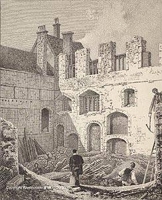
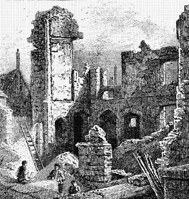
(The illustrations show the ruins of the Minories in the late eighteenth century. No trace of it remains today.)
The house of the Grace of the Blessed Mary was founded outside Aldgate in the parish of St. Botolph in 1293 by the brother of Edward I, Edmund earl of Lancaster, for enclosed nuns of the order of St. Clare, or Minoresses, as they became known. The first members of the convent were brought to England by the earl's wife Blanche, queen of Navarre, probably from France.
From the earliest foundation the house enjoyed important privileges, but the house seems at first to have been richer in privileges than in revenue. Later they were granted financial exemptions, which may possibly reflect the nuns' poverty, and powerful influence exerted on their behalf, since the house always had a particular attraction for persons of rank. John of Gaunt, for example, bequeathed £100 to be distributed among the sisters.
From the time of Margaret de Badlesmere, who was living in the nunnery in 1323, well born widows found a retreat from the world at the Minories. Relations between the nunnery and the family of Edward III’s son, Thomas de Woodstock, Duke of Gloucester, appear to have been of the closest kind. His house adjoined the conventual church, and the abbess and sisters allowed him to make a door between the two buildings so that he could enter the church as he pleased. His Duchess died in the nunnery, and one of their daughters, Isabel, who had been placed in the nunnery at a very youthful age, chose to remain as a nun, and became abbess.
This connection with the royal family accounts for the favour shown to the Minoresses by Henry IV, who confirmed privileges granted to them by his predecessors, and decreed that no justice, mayor, or other officer should have any jurisdiction within the precinct of the house except in the case of treason or felonies touching the crown. In 1461 Edward IV granted the Minoresses property 'on account of their poverty'. It was within the convent precincts, ‘in the great house within the close’, that several ladies chose to live apart from the world at the turn of the sixteenth century; and it may be that with them lay the evidence of what really happened to the Princes in the Tower. And at that time the convent enjoyed the charity of Elizabeth of York, who was related to the Abbess.
In 1515 twenty-seven of the nuns died of some infectious complaint, so that there could hardly have been less than thirty or thirty-five before the outbreak. The abbey was dissolved in March, 1539. The old convent buildings were destroyed in a fire in 1797, and their remains demolished.
DVD EXTRAS!
This book, originally titled Innocent Blood, contains two intertwined stories. The original text - at 642 pages - was thought to be too long, for commercial reasons (the book would have had to be priced higher), so over 140 pages have been cut by the author during the editing process. However, to give readers a flavour of the book, some of the cut passages now appear here. The first is a scene that takes place in June 1483. Kate is Katherine Plantagenet, the illegitimate daughter of Richard, Duke of Gloucester (the future Richard III), and she is planning an adventure...

Pleading that she was hot and needing to go indoors to get a drink, Kate sought out Mattie, finding the little maid in her bedchamber, mending a hem.
‘I want to go to Westminster,’ she said. ‘Will you come with me?’
‘Why, mistress?’
‘I want to see the palace and the abbey,’ Kate told her, ‘but it’s a secret. I don’t want the Duchess or my father to know I have gone there.’
Mattie grinned broadly. ‘You can trust me, my lady,’ she said. ‘And it sounds to me as if there’s more to this than just sight-seeing.’
‘There is!’ Kate confirmed.
‘Well, I’m always up for an adventure,’ Mattie said, hanging the mended dress on a peg. ‘Let me just use the privy, and I’ll be with you.’
Kate told the Duchess that they had decided to go shopping in Cheapside.
‘Again?’ Anne said, smiling. ‘It’s a good thing your father gives you a generous allowance! Enjoy your afternoon.’
They hastened down to St Andrew’s Hill and caught a boat at the water-gate there. The boatman was garrulous, grumbling about the press of traffic in the river and the stinginess of his previous customer, who hadn’t tipped him, and he also had a deal to say about the Duke of Gloucester. Kate sat tight-lipped as he predicted, mark his words, that the Duke was bent on seizing the throne.
‘How do you know that?’ Mattie asked, sensing Kate’s anger.
‘’S common knowledge. Stands to reason. He had Lord Hastings put to death, and sure it is Hastings was murdered because of the truth and fidelity he bore to the King. And look at the poor Queen, in sanctuary and in fear for her life. I don’t know. What is the world coming to?’
Kate was hard-pressed to keep her mouth shut, but Mattie was never reticent. ‘That’s all rubbish,’ she declared. ‘The Duke is my master, and I could never find a kinder. Don’t believe all the nonsense put about by his enemies!’
The boatman looked as if he was about to retort, but changed his mind, and the rest of the journey passed in silence. When the two girls alighted at the stairs below the King’s Bridge at Westminster and paid their fare without any extra, he stuffed the pennies in his leather jerkin and rowed off without a word.
‘That shut him up!’ Mattie said.
‘I am really grateful to you,’ Kate told her, ‘and I know my father the Duke would be proud of your loyalty.’
‘It’s nothing,’ Mattie replied, but she was pleased - you could see it in her face.
Kate had never been to Westminster, and when she passed through the great stone gateway by the river, she was awed at the huge complex of stately buildings surrounding her. But it was disconcerting to see the place swarming with soldiers. There was a long armed chain of them encircling a massive church that Mattie said was Westminster Abbey, and all were armed with swords and staves. Crowds of people were standing at a safe distance, watching, held back by more armed men. Kate was already beginning to wonder if she had been foolish to come here, when not a stone’s throw away she saw a large group of lords, conferring among themselves; among them was a short man in black, who had his back to her, and immediately she recognised her father.
‘Quick!’ she whispered. ‘He mustn’t see me!’
She grabbed Mattie’s arm and pulled her into the shelter of a doorway, then, realising that it was a cookshop, hastened inside. They would be inconspicuous in here. The place looked reasonably clean, and smelled deliciously of baking bread and roasting meat – although these aromas could not quite mask the whiff of unwashed bodies and stale sweat. Resolutely ignoring that, she quickly purchased two small hot manchet loaves filled with slices of steaming roast beef, and sat down with Mattie at a table away from the window to eat them. From here, they had a good view of what was going on just across the road. There were many men in armour milling about, so sometimes the view was obscured, but they were able to observe the Duke conferring with a very elderly man in the red silk robes of a cardinal, then saw the venerable father nod, bow and make his way towards the far end of the abbey, where he turned a corner and disappeared; with him went many important-looking lords and clergymen.
‘The sanctuary’s up there,’ Mattie said. ‘Just off Thieving Lane. It’s aptly named, for most of those who seek sanctuary are robbers and cut-throats; the Queen is in poor company.’
‘She’s not in the common building,’ Kate told her. ‘The Duchess told me she is lodged in the Abbot’s house.’ Mattie snorted at that. She had no love for the Queen.
The Duke and his colleagues, amongst whom Kate recognised the Duke of Buckingham, remained where they were, their restlessness betraying their impatience. Kate had been shocked to see so many soldiers here, even though she guessed they were there to preserve her father’s safety. All this for the sake of one small boy, though! If only the Queen wasn’t being so stupid and difficult.
Nothing was happening, so Mattie took the opportunity of pointing out Westminster Hall, a magnificent building across the way, and the King’s great palace beyond it. ‘That tall building is St Stephen’s Chapel,’ she said. Kate had heard the Duchess Anne speak of it several times.
‘That is where my lord father and the Duchess were married,’ she told Mattie. Then she paused, troubled, because she was coming to realise that there had been a growing coldness between her father and stepmother of late, a coldness that had never been evident at Middleham. It had begun, she was certain, on that evening when her grandmother had been present, and her father had shouted at Anne after Anne had questioned the legality of his proceedings. Since then, Anne had held herself a touch aloof from him, observing the proper courtesy due from a wife to her husband, but little of her former warmth. Yet surely Anne could not but approve of the measures the Duke had taken to ensure his safety and prevent the Wydevilles from seizing power? Not so long ago she had been in desperate fear for him, but now it seemed as if she was doubting him and paying heed to vicious gossip, which was not like her; and Kate was sure there was something that Anne was not telling her. Dare she ask her what it was? It might not be seemly to touch upon such personal matters.
‘Penny for them, mistress!’ Mattie giggled.
‘Oh, I’m sorry,’ Kate apologised, and fixed her gaze on the scene beyond the window, which had not changed.
A man waiting at the counter began loudly voicing his opinions. ‘Seen what’s happening out there?’ he asked the cook. ‘That’s the Duke of Gloucester, come to fetch the little Duke of York from sanctuary. He’s sent in the Cardinal to get him out. If you ask me, the Cardinal is here to make sure the Duke’s men don’t violate the sanctuary.’
‘Some hope then,’ replied the cook, a beefy, red-haired man in a stained apron. ‘What could one old man do against all those soldiers.’
‘I’ll wager you, if the Queen won’t give up the boy, Gloucester will send in the soldiers and force her to. Why else has he brought them?’
Kate had to speak up. ‘Because the Marquess of Dorset is at large, and wishes him ill,’ she said stoutly.
‘My, you’re a well informed young lady,’ the man retorted, and the cook and his other customers laughed. ‘But you must be the only person in London who doesn’t suspect the ambitions of the Duke.’
Kate sat down, reddening, knowing that she dared not declare her identity here. She sat there unspeaking, furious with the man, and with herself for speaking out.
‘Cat got your tongue, has it?’
‘Best not to say anything, mistress,’ Mattie murmured.
Kate nodded, and looked out again, resolutely ignoring the guffaws of the men at the counter. At length, they lost interest in her and returned to their talk.
‘It wouldn’t be the first time Gloucester’s violated sanctuary,’ a middle-aged man said. ‘Remember Tewkesbury? He had the Duke of Somerset and other Lancastrians dragged out of the abbey to summary execution. Saw it myself: I served on that campaign. There was no trial, nothing. The Duke said it was his right as Constable of England.’
Kate froze. She was remembering her father’s words at table. I am not a sanctuary breaker. Surely, he had had every right to apprehend those men who had sought sanctuary at Tewkesbury? But she knew very little about the privileges he enjoyed as Constable of England, so she kept her mouth firmly shut. If he had said he had the right, then he must have had. Yet she could not help recalling that the Duchess had seemed to be unconvinced, and she remembered wondering if Anne knew something that she did not. Anne, she was aware, had then been on the Lancastrian side; her father Warwick had married her to Henry VI’s son, Edward of Lancaster, but Edward had been slain at Tewkesbury; it stood to reason that Anne would then have been willing to believe all the calumnies about the Yorkists that must have been circulating afterwards.
Something was happening at last. A cleric came hurrying from the direction of the sanctuary, bowed to the lords, and spoke to Gloucester. He then beckoned the rest, and led them off towards the palace, where they disappeared into Westminster Hall. Then the Cardinal and his party emerged from the sanctuary, and with them they had a small, fair-haired boy. Kate knew that it was her cousin, the Duke of York. She had never met him, but she could see that he was a beautiful child, and that he seemed quite merry, skipping along beside the elderly primate. Certes, her father had been right, and the boy was no doubt delighted to be out of sanctuary and away from the cloying company of his mother and sisters.
The Cardinal led his charge into Westminster Hall, and then the soldiers began to disperse, only a few remaining on duty near the sanctuary. The crowds evaporated too, now that there was nothing more to see, and Kate and Mattie got up to leave. There was no point in staying, and Kate wanted to be home before her father returned.
Kate's story is interlaced with that of Lady Katherine Grey, the younger sister of Lady Jane Grey. One of the story threads about Katherine, which appeared at intervals throughout the book, has been cut, but appears in part below.
I recall in painful detail – how could I not? - the day I finally left my prison. They had to drag my little boy from my arms, I screaming and wailing, and the child roaring with fear and fury.
‘He is to go with his father,’ they said, and carried off the yelling child. He was but two years old! And I have never set eyes on him since.
They left me my younger son, a babe in arms. They took me, all downcast and bereft, to the house of my uncle, Lord John, at his house, Pirgo, in Essex – he who is also owner of the Minories. He could never abide me, having no time for educated women, and I have no doubt he took great pleasure in following official orders to the letter. I was, throughout my hateful stay under his roof, treated as if I were in custody, and not allowed to write letters or speak to anyone but my guardian. It was part of my punishment, I was told. ‘The Queen means no more by this liberty than to remove you from all danger of the plague,’ he informs me. ‘You are to behave here in my house as if you were in the Tower.’
It was obvious that Lord John could not wait to be rid of me. For a long time, he did as much for me as he had to, and no more. I was housed and fed, but in nothing like the state I had been used, even in the Tower.
After months of this treatment, hoping that tempers might have cooled, I wrote to Mr Secretary, begging to be reunited with my dear lord and my eldest son, and begging him to intercede for me with the Queen’s Majesty. I can recall the grovelling words I wrote, my abject plea for the obtaining of her most gracious pardon and favour towards me, which, with upstretched hands, and down-bent knees, from the bottom of my heart most humbly I craved.
There was no reply. Seeing me sobbing continually, and ailing because I was pining for my husband and child and could take little food in my distress, even Lord John took pity on me.
‘I have watched you take but six spoonfuls of this excellent stew,’ he says. ‘Good Madam, eat something to comfort yourself, for your health’s sake. Come now, there is no cause to weep again.’
‘Alas, Uncle!’ I cried. ‘Why should I not weep? What a life is this to me, living in the Queen’s displeasure! But for my lord and children, I would to God I were dead and buried!’ Whereupon he himself wrote to Mr Secretary, asking him to ease me of my woeful life.
Again, no reply. So I marshalled all my courage and scribed a letter to the Queen herself. Again, I grovelled: ‘I dare not presume, most gracious sovereign, to crave pardon for my disobedience. I acknowledge myself a most unworthy creature. My misery and continual grief teaches me daily, more and more, the greatness of my fault, and your princely pity increases my sorrow that I have forgotten my duty to your Majesty. This is my great torment of mind.’ Humbly, on my knees, I craved her pardon once more.
Seeing my anguish, my good uncle permitted me to write to my lord to tell him of my petition. And of course, I swooped on the chance, for now I could assure my dear love that my feelings for him were as strong as ever, and that our long parting had not made any difference to that.
"It is no small joy, my dearest lord, to have the comfortable news of your good health. I beg God to give you strength, as I doubt not he will. Neither you nor I can have so much comfort in this lamentable time as the assurance of good health in us both.
Though of late I have not been well, yet now I thank God I am recovering, and long to be merry with you, as you were with me when our sweet little boys were begotten in the Tower. You were my naughty lord then! Could you not have found it in your heart to have pity on me, giving me more pains for more brats, so fast, one after another? No, I jest: I was only having regard to resting my bones! I should remember the blessing of God in giving us such increase of children, although we are forever beggared. I should have been glad to have borne a great deal more pain, than accounted it too much trouble to bring them into this world, so much is my boundless love to my sweet bedfellow that I was wont with joyful heart to lie by, and shall again, I know it.
Thus most humbly thanking you, my sweet lord, for sending to see how I do, and also for your money, I most lovingly bid you farewell. I bid you farewell and always good health, my good husband.
Your most loving and faithful wife during my life, Katherine."
I waited for a reply from the Queen. Days, then weeks passed, and no word came.
I wrote again, pleading, to Mr Secretary: ‘What the long want of the Queen’s Majesty’s accustomed favour towards me has bred in this miserable and wretched body of mine, God only knows. I wish to God to be buried in the faith and fear of Him, rather than live in this continual agony.’ My crushing disappointment had indeed made me ill, and I took to my bed, coughing and feverish. Lord John came to me in concern. He begged me to get up, or at least cease my crying, but I could not. He said he could not sleep in quiet for worry about my health. He saw me coughing up phlegm, and trembled in case I might be suffering from consumption. I suspect he feared I might die in his charge.
I did not. But Lord John was hauled off to the Tower for showing me too much favour and exhorting the Queen to forgive her enemies. And thus it was that I and my child were moved, all in a hurry, to Ingatestone in Essex.
At Ingatestone Hall, in the custody of an unwilling yet courteous Sir William Petre, I knew despair. I had lost the will even to write letters to my husband. I had convinced myself they would never be delivered. Yet for all that, my health mended, for at last I knew a glimmer of hope.
I had overheard my attendants gossiping, saying that the Queen now favoured my succession above that of the Queen of Scots. After that, every day, I would stand at a window on a stairway and look out to see if a messenger came. I was in such a fever of anticipation and longing that I haunted the place, fearful to leave in case deliverance should come and I not be aware of it. Mayhap, when I am long gone, my ghost will stand there, if it be true that ghosts walk where once there were strong passions.
But then, for some inexplicable reason, Sir William grew cold towards me. It was not until many months later that I learned the reason. My sister Mary, that poor, hunchbacked little person, who yet had a fiery determination and a fervour for religion – and much else, as it turned out – had made a secret marriage. That was bad enough, in the Queen’s eyes – and I could imagine her rage when she found out – yet it was rash in the extreme, and even I could not approve of it. For Mary had not even chosen a man of noble birth to be a partner in her offence; instead, she had eloped with one Keyes, a sergeant porter at court. The scandal was immense, and it reawakened all Elizabeth’s anger towards my family. My hopes of freedom were dashed, had I but known it at the time.
So there we were, sisters in crime, and both under house arrest. No wonder Sir William wanted to be rid of me, for apart from all this bother he was in increasingly poor health. And thus it was that I was parcelled off to the keeping of the ageing Sir John Wentworth at his fine big house, Gosfield Hall, near Halstead.
At Gosfield Hall, I thought I might die. For all my luxurious surroundings, and the comfort in which I was housed, I was kept in isolation, rarely seeing my ancient custodian or his lady. My days were full of lamentations, my cheeks grew pale, and I developed another troublesome cough. I was not ill-cared-for, or badly served, but my longing for my sweet lord and our eldest son grew, if anything, more intense, until it was like a physical pain. I smuggled out endless letters to my beloved, with the help of my maids, receiving the same in return, with many tokens of his devotion. But our separation was killing me. I would lie in bed at night, biting my pillow to stop myself crying out in anguish.
I could not accept my situation. I was not patient like Griselda of old. With me, it was all or nothing. If I could not have my husband and son, I would prefer to die.
I gave up hope of my release. I knew that that could only come about with the Queen’s death, and from what I had heard, she was in robust health, although still unwed. And always will be, I thought grimly. If there was any support for me at court, or in the country, I knew nothing of it.
Mrs Ellen died. I know I was a trial to her during her last years: she could do nothing with me. It broke her health, to see me so low. But one thing she told me, which did revive me somewhat - for a time, that is, until hope died. She said she had heard Sir John telling a guest that my sweet lord had not ceased to appeal and petition against the verdict on our marriage. It made me weep, knowing that his love remained strong, and that he was prepared to court censure and even danger for my sake. It was Mrs Ellen’s last great gift to me.
My cough grew worse. It was accompanied by pains in my chest. I lost interest in food, and grew thinner. At night I began to sweat; by day, I found everything an effort. I put it all down to grief over my endless troubles and miseries.
By the time Sir John Wentworth died late last year, and I was moved, still a prisoner, to yet another place of confinement, I was in a very poor case indeed.

Originally this was going to be a very different book, a novel about Perkin Warbeck. But when I came to write it, I felt that the story was going to lack credibility because of being based on Perkin Warbeck's dubious account of how, as 'Richard, Duke of York', he escaped being murdered in the Tower. So it was decided that I should embark on the project that became A Dangerous Inheritance. But here, for those who are interested, is the original submission.
THE PRINCE FROM THE TOWER
A proposal by Alison Weir

(L-R: Richard, Duke of York; Perkin Warbeck; Edward IV)
In this novel, I want to revisit an old mystery – or rather, two old mysteries. That surrounding the disappearance of the Princes on the Tower is notorious, and still attracts heated debate, yet the enigma of Perkin Warbeck - who claimed to be one of the Princes and lost his life for it - while equally intriguing, is far less controversial and rarely discussed. As a historian who has written on both subjects, I have my own views, but as a novelist, I can make that extra leap of the imagination and present solutions to both mysteries, solutions that could be justified by contemporary evidence. And even if that evidence lacks credibility in parts, we must always remember that history is usually written by the victors, and that the stories of victims of judicial murder are often deliberately distorted. I am not saying that this is what actually happened… but that it could have happened. And of course, we shall never know the truth.
In the summer of 1483, the young King Edward V and his younger brother, Richard, Duke of York, were placed in the Tower of London by their uncle, Richard of Gloucester. Soon afterwards, Richard had the two boys proclaimed bastards, on the trumped-up grounds that their father Edward IV had never lawfully been married to their mother, and usurped the throne as Richard III. For a short while afterwards, the Princes in the Tower, as they would become known, were seen playing and shooting with bows and arrows in the gardens there. But then, as it became clear that their very existence was a threat to King Richard, they were confined to the White Tower and soon afterwards disappeared from public view, never to be seen again. Grown men wept when they were mentioned, and their disappearance fuelled rumours, both in England and abroad, that they had been done away with by their unscrupulous uncle.
But were they? And what was the true identity of the young man called Perkin Warbeck, who emerged from obscurity eight years later, claiming to be Richard of York, the younger of the two Princes?
The thrust of this novel is that Warbeck really was the younger of the Princes in the Tower. It opens with a short but dramatic prologue set in the Tower of London in 1483, recounting how Richard, Duke of York was spared by his brother`s murderers. This passage is based on the account that Perkin Warbeck himself gave – to the Spanish sovereigns, Ferdinand and Isabella, no less – describing what had happened to him in the Tower as a child. According to this, he had been spared by the men who murdered his brother, and entrusted to another man who was under orders to kill him. However, that man had been struck by the innocence of his potential victim, taken pity on him and saved his life. He had sent him abroad, having made him swear on the Blessed Sacrament not to disclose his birth and lineage until it was safe to do so, and since then, the boy had lived overseas, at Tournai, in the care of a converted Jew, John Warbeck, and his wife Katherine, who came to look upon him as the son they had never had.
But the growing Richard knew very well who he really was. His memories of his royal parents and the Yorkist court were vivid. He lived with the dangerous knowledge that, his brother, Edward V, having been murdered, he himself was the lawful issue of a lawful union, and the rightful king of England. He also knew that the man who had usurped his throne had been killed at the Battle of Bosworth just two years after his own escape from the Tower, and that another usurper, Henry VII, first sovereign of the House of Tudor, now wore the English crown, and had married Richard`s own sister, Elizabeth of York. Richard grew to maturity with a strong sense of his own identity and a burning desire to right the injustice that he been done to him.
At length, in 1491, at the age of eighteen, he decides to press his claim. This is where we first encounter the adult Richard, at the time of his appearance in Ireland. Because most people believe him to be dead, his friends and advisers are urging him to assert his right to be King of England by claiming to be Edward, Earl of Warwick, a nephew of Edward IV and Richard III, and the Yorkist claimant with the strongest claim to the throne. The real Earl, a feeble-minded boy of sixteen, has been imprisoned in the Tower by Henry VII. Henry knows that his own title is weaker than Warwick`s, and that there are many who regard him as a usurper. Thus Warwick has to be kept safely confined, in case anyone gets ideas about staging a coup in his name.
So the young man in Ireland could not be Warwick, and very quickly his advisers realise that to claim this was rather foolish. Almost immediately, they proclaim his true identity, announcing that he is Richard, Duke of York, the younger of the two Princes and the rightful King of England. Without hesitation, the pro-Yorkist Irish rally to his banner, as do many prominent Yorkists. When they come face to face with the tall, golden-haired young man, they are impressed by his dignity, his air of authority, his courtly manners and his vitality and energy. Many are struck by his close physical resemblance to
Edward IV; he even has a cast in the eye that is characteristic of the Plantagenets. There is about him an aura of majesty that sets him apart from other mortals, while his charm and dynamism are irresistible.
Richard is at first overwhelmed by this enthusiastic acceptance and acclaim, and is filled with optimism for the success of his daring venture. Although there is naturally in him some bitterness at being deprived thus far of his rights, he does not see himself as a victim but rather as a young man facing the ultimate challenge, with God on his side. He will win through – he will rule England, and rule it with justice and mercy. He will be a king to be proud of, a king who will justify the hopes of his loyal supporters.
News of the emergence of this latest pretender causes Henry VII the greatest alarm. He has just suppressed a rising in favour of an earlier pretender, Lambert Simnel, who is now working as a scullion in the royal kitchens. His supporters were less fortunate, having been slaughtered at the bloody Battle of Stoke four years ago. And Henry is constantly aware of the existence of Warwick, another potential focus for rebellion. So he regards the young man in Ireland as a deadly threat to his throne.
Things look even worse for Henry when the King of France welcomes York to his court with all the honours due to a visiting sovereign and offers him his protection. Louis takes one look at Richard, whose father he knew well, and knows that the royal blood of England is standing before him. For Richard, it is a pivotal moment, this acknowledgement by a brother monarch. It gives him even greater hope for the future…
Poltical pragmatism prevails, however. Louis is sufficiently a realist to know that real power lies with the man who actually occupies the throne, rightfully or not, rather than with the man who ought to be sitting there. For reasons of policy, he needs an alliance with England, and in 1492, when it is concluded, Louis regretfully intimates that Richard must leave France and seek a patron elsewhere. It is a bitter blow to the young man, but soon he is planning once more how best to assert his claim. And where better to find refuge and support than at the court of his aunt, Margaret of York, Duchess of Burgundy, in the Low Countries?
Margaret of Burgundy, the sister of Edward IV, the Princes` late father, and Richard III, hates Henry VII, and longs for nothing more than the restoration of the House of York to the English throne. She has even gone so far as to support the Lambert Simnel conspiracy. Now, seeing in the young Richard such a marked resemblance to her late brother Edward, she warmly and unreservedly welcomes him as her long-lost nephew, and fetes him as the rightful King of England. Her stepson-on-law, the Archduke (later the Emperor) Maximilian, ruler of the Low Countries, follows suit; he is not so sure of the young man`s real identity, and really cares little either way, but he know very well that he will be politically useful. With such powerful friends behind him, Richard reasons, his cause cannot fail.
News of these events comes blazing and thundering into England, causing numerous people to wonder whether the Princes had died in the Tower after all. Many declare for York, convinced that he really is the man he claims to be. Realising to his alarm that this pretender is the most dangerous of them all, Henry VII sends his spies to uncover what they can of his background.
In the summer of 1493, they report that his real name is Perkin Warbeck, and that he hails from Tournai in Picardy – or so the King claims. He wastes no time in making an outraged protest to the Archduke Maximilian, accusing him of harbouring an imposter. But Maximilian, convinced that his guest is genuine, ignores Henry. Enraged, Henry, heedless of the cost to his subjects, places a ban on England`s lucrative trade with the Low Countries – to which Maximilian responds by taking Richard with him to Vienna, to his own father`s funeral. Accepted and feted by the cream of European royalty and nobility, Richard is convinced that it is only a matter of time before he is crowned at Westminster in the seat of his forefathers.
By 1494, having heard convincing tales of his commanding presence, his undoubted royalty and his qualities of leadership, many Englishmen have crossed the Channel and offered Richard their allegiance. That year, spurred on by the encouragement of his loyal followers, he returns to Ireland, intending to use it as a springboard for an invasion of England. But Henry VII promptly sends his deputy there to kick him out, and has his agents round up Richard`s adherents at home; many are imprisoned or executed, thus depriving him of any cohesive support in England. It is a bitter moment – will he be forever doomed to be disappointed of success?
With the dogs metaphorically at his heels, Richard flees back to Flanders, where Maximilian urges him to invade England and seize his birthright. Re-energised, Richard begins assembling men and ships. The threat is so imminent that Henry VII is forced to place his kingdom on invasion alert. Richard attempts a landing, but is driven back at Deal. He is determined, however, never to give up. After more wanderings and political manoeuvring, he seeks refuge in Scotland, at the court of the sympathetic James IV, who is gleeful at having this chance to embarrass and discountenance his English neighbour.
At this juncture, we are introduced to the beautiful dark-haired beauty who will become Richard`s wife and the love of his life. Lady Catherine Gordon is the King`s kinswoman, a spirited young woman of nineteen who has so far thwarted all the attempts of her father, the Earl of Huntly, to find her a husband. When she hears that King James, aiming to cement his friendship with Richard by a marriage alliance, has chosen her to be the pretender`s bride, she is scornful and dismissive, disdaining to wed a man whom she believes to be low-born adventurer. But, brought face to face with Richard at James`s court, she takes one look at her future husband and is lost.
The attraction is mutual and overwhelming. It is patently clear to Catherine that here is a royal husband for her, but what delights her even more than the prospect of hopefully becoming queen of England is the knowledge that hers will be a love match – rare among royal unions. Richard is utterly captivated by his alluring bride, and the consummation of their love is tender and joyful. Catherine will from now on be his staunchest supporter, the person who believes in him more than any other, but the dramatic course of their lives together will be both passionate and painful.
In 1496 Richard accompanies James on a raid into England, but is disgusted by the Scots` needless pillaging and destruction of English property. After he protests at this, James makes it clear that he is no longer welcome in Scotland, so Richard sails to Ireland once more, taking his beloved Catherine with him. There he manages to dodge the King`s deputy and raise a force. In 1497, with Catherine by his side, he lands in Cornwall and marches on Exeter, where he lays siege to the city. But when Henry VII sends a massive army against him, he is forced to flee. He is hunted down and captured soon afterwards, and brought before the King. He learns, to his anguish, that Catherine is a prisoner too. Defeat is staring Richard in the face, and he fully expects to suffer the full horrors of a traitor`s death.
But Henry is remarkably lenient with him; after they have had several meetings, he discovers he even likes Richard, and Richard finds himself feeling a begrudging admiration for Henry. But Henry wants the truth – or as much of it is consistent with him holding on to his throne. Facing interrogation, and aware that it will go better for him if he admits to being merely a pretender, and that it might be his only chance of surviving to fight another day, Richard makes the confession that Henry requires. As a punishment, the King sends him briefly to the Tower, but soon Richard is brought back to court, where he is nobly housed but obliged to live under guard. Henry is plagued by doubts as to his true identity – he has never uncovered the truth about the Princes` disappearance – and he feels it is safer to have the young man under his eye. As an added precaution, Richard is forbidden to sleep with his wife, in case she gives birth to future pretenders. This is a cruel blow to the lovers, but at least Richard has the comfort of knowing that Catherine is honourably housed under the Queen`s protection. The Queen is, of course, his sister, Elizabeth of York, and she is well-aware that he is her brother, but for various reasons – not the least of which is her love for her husband – she keeps her counsel.
Richard and Catherine live at court for eighteen months, but by 1498 Richard is chafing at the silken chains that bind him, and attempts an escape. He is caught within hours, and this time Henry VII is not so lenient. He has the young man confined to the Tower in a dark cell. People who see him a year later are shocked to see how this gruelling experience has aged him.
It is more than coincidental that the Earl of Warwick is lodged in a cell nearby. Henry VII is resolved to be rid of both young men once and for all, and in 1499 an agent provocateur is planted among their gaolers with instructions to lure them both into a conspiracy against the Crown, and thus give the King a pretext for sending them to the scaffold.
The ploy works. Richard is desperate to escape, and consumed with anger at his hopeless situation. His cousin, the feeble Warwick, is a willing tool and easily persuaded of the rightness of Richard`s cause. Inevitably, the two prisoners plot to escape and overthrow the Tudor monarch. Apprised of this by their insider, the government has them tried and condemned to death. In desperation, the distraught Catherine disguises herself as a prostitute and bribes her way into the Tower for one last poignant meeting with her husband.
In November 1499 Richard, the true King of England, is beheaded at Tyburn. On the scaffold he publicly swears that he was not the son of Edward IV – knowing that an oath given under duress is no true oath. He dies bravely, his manner kingly to the last.
His grief-stricken Catherine is watching in the crowd. Only she knows about that stolen meeting in the Tower – and only she knows that she is carrying in her womb the true heir to England. What happens to her and that heir is, of course, another story…
Historically, there have been many theories that at least one of the Princes escaped from the Tower and grew to maturity in obscurity. Perkin Warbeck maintained that he was Richard of York for so many years that many believed he was indeed the younger Prince. In life, his bearing, his knowledge of court manners and of the House of York all lent credibility to his claim, as did his acceptance by so many European crowned heads. He looked like a scion of York, and facially he was the very image of Edward IV. He was the same age as Richard of York would have been, had he survived, intelligent and well-spoken as befitted a royal prince.
Everyone loves a conspiracy theory, and this tale has more than one. Packed with secrets, intrigues, violence and adventure, and set in the lavish Renaissance courts of England, France, Scotland and the Low Countries, the glorious landscapes of Ireland and the West Country and the grim ambience of the Tower of London, it is also a beautiful and tragic love story, woven around two doomed lovers. Above all, it is the chronicle of England`s lost King, the rightful Richard IV.




